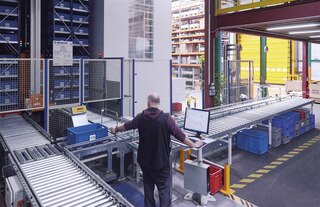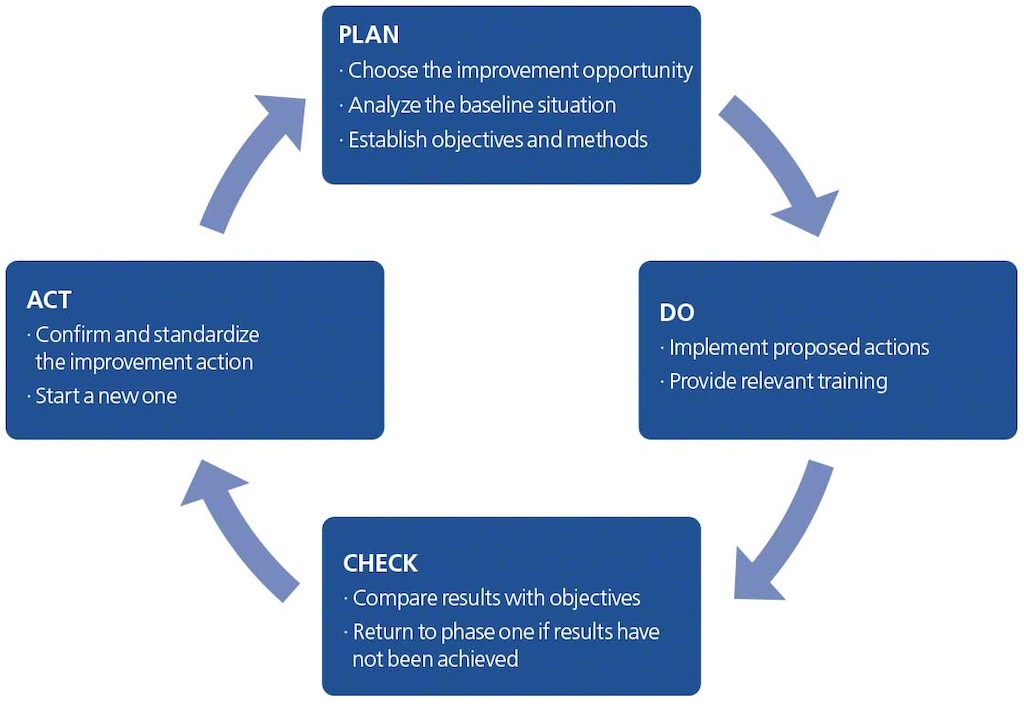
PDCA: how to apply the Deming cycle in logistics
PDCA (plan–do–check–act), or the Deming cycle, is a quality management method used to employ a continuous improvement strategy in a company. This facilitates problem solving, thus, in a structured, systematic way.
This four-step procedure was made popular by the American consultant William Edwards Deming, although its creation is attributed to his mentor, Walter Shewhart. Deming, an expert in quality management systems with an in-depth knowledge of statistics, worked with engineers and scientists to implement the PDCA cycle in Japanese businesses throughout the 1950s. But it wasn’t until three decades later that his methodology in favor of maximum quality would become ingrained in industry in the US.
What is the PDCA cycle?
The PDCA cycle, also known as the continuous improvement spiral, is a method geared towards optimising a procedure by identifying the cause of a problem and correcting it. The Deming circle is normally depicted as a wheel, as it’s conceived of as a cyclical process:

The PDCA cycle encompasses (1) the planning of an improvement action based on a recurring problem, (2) the controlled adoption of the proposed solution, (3) the subsequent analysis of its functioning (to identify differences between what was planned and what was executed), and, finally, (4) the standardisation of the corrective adjustment, with the purpose of establishing the new optimised process in the company.
The four Deming wheel phases applied to logistics
Let’s go over in detail each step of the PDCA cycle:
1. Plan
The objective of this stage is to define the problem or procedure you want to improve. In logistics, some situations that might benefit from being put through the Deming cycle might be: picking and packing errors, order prep, a high returns rate and the delivery of damaged packages, among others. Carrying out an exhaustive control of the warehouse using defined metrics is essential for identifying areas that aren’t performing as they should.
This step of the PDCA cycle can be broken down into three subprocesses:
1. Identify the improvement opportunity and analyse the starting situation: it’s necessary to focus on the causes of the problem, delving into the whys. The Pareto principle can be useful here. Just as it’s relevant for the ABC analysis for warehouse management, this rule can also serve to set priorities arising from logistics issues. Typically, the bulk of adverse effects of a problem (80%) are due to few causes (20%).
2. Set measurable targets: they should be specific, achievable, relevant and results-oriented. Additionally, it’s necessary to designate a time frame for their assessment. These objectives can be based on historical data registered by the firm when establishing KPIs or on sector-based data resulting from benchmarking of the competition.
3. Prepare an action plan: this includes studying and choosing the most appropriate corrective measures, the employees in charge of each action and the implementation dates. It can be considered as a pilot test that’s then rolled out in the other areas if the results are satisfactory.
2. Do
The “do” phase of the PDCA cycle is also known as the test phase. It consists of performing the chosen action and eliminating the causes of the problem. To ensure that this is carried out smoothly, it’s advisable to prepare instructions and training for the employees involved and register any deviations from the initial plan.
3. Check
This step relates to evaluating results, comparing the plan implemented with the one devised. The information collected is normally used to create data visualisation tools, including graphs and diagrams. One important point here is to observe the time limits set so as not to get ahead of ourselves and jump to conclusions.
Following this results assessment, there are two options:
- The goal has been met, in which case, the Deming cycle advances to the next stage (act). It’s vital to check the rest of the metrics to guard against “side effects,” meaning, you need to make sure that no problems have been uncovered or increased in other areas.
- The goal has not been met: if the reason is that the plan wasn’t adequately put into practice, you’ll need to return to the previous phase and thoroughly review its deployment. If this can be ruled out, you’ll have to go back to the beginning of the Deming wheel to study the root of the problem once again.

4. Act (or adjust)
Once the cycle has proven to be successful, it’s necessary to document, standardise and monitor the change. This information should be made available to staff by, for example, organising training sessions. To thoroughly follow up on the new processes, it’s also relevant to designate KPIs to be tracked.
In addition, if new tools have been successfully tried out, they need to be put in place extensively. So, if the pilot test with voice-picking devices has been shown to be effective for reducing order prep errors, it would be a good idea to suggest to logistics managers that all operators use this technology.
Benefits of the PDCA cycle
The main advantages to deploying the Deming wheel are that it:
- Provides a standardised method that can be used in any business area to resolve recurring issues.
- Saves time when searching for the ideal solution.
- Works as a road map for ensuring the complete implementation of a project.
- Guarantees the detailed analysis of common errors in order to rectify them.
- Serves to monitor and document the start-up of new processes.
- Establishes a guide for action by eliminating the root of a problem, regardless of whether there are personnel changes.
- Foments teamwork thanks to the active participation of all stakeholders.
How does PDCA enhance a company’s logistics quality?
In logistics, quality means satisfying customer demand at the lowest cost without ever compromising the service level. The key is to find the perfect balance between cost and service quality.
The cost of quality and non-quality
Linked to this concept are two types of costs:
- Quality costs: these are associated with obtaining the required quality. They relate to, for instance, the deployment of an industrial preventive maintenance plan in an installation for proper system upkeep.
- Non-quality costs: these stem from a lack of quality in processes. An example would be losses due to downtime or machinery malfunction.
Tools for efficient warehouse management
Quality enhancement is a constant objective in logistics, as it’s synonymous with increased productivity. The ultimate goal is to “do it right the first time.” To accomplish this, employing methods such as PDCA to warehouse processes is key for boosting a company’s logistics efficiency.
Implementation of the Deming cycle can be complemented by new systems and equipment to maximise all processes in the facility. The installation of a warehouse management system in the installation strengthens the employment of the PDCA methodology, since the WMS automatically collects and processes a huge amount of information.
In addition, tools such as Supply Chain Analytics Software facilitate the analysis of these data via personalised dashboards and graphics, increasing efficiency in key phases such as stock inflows and outflows, order prep and inventory management, among others.
Technological innovation boosts the PDCA effect
The end aim of logistics quality is to achieve continuous improvement of service while keeping costs as low as possible. In fact, two out of ten respondents of Deloitte’s Supply Chain Digital and Analytics Survey consider the reduction of logistics costs to be the first objective in their commitment to data analysis tools.
The monitoring of processes ensures the optimal deployment of the Deming cycle, which can be most effectively implemented through the use of IT systems. To learn more about the advantages of warehouse management systems, get in touch. We’ll show you how they work in a personalised demo.
